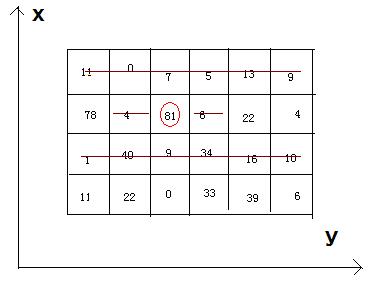吃土豆_nyoj_234(动态规划).java
2013-08-13 11:46
281 查看
吃土豆
时间限制:1000 ms | 内存限制:65535 KB难度:4
描述Bean-eating is an interesting game, everyone owns an M*N matrix, which is filled with different qualities beans. Meantime, there is only one bean in any 1*1 grid. Now you want to
eat the beans and collect the qualities, but everyone must obey by the following rules: if you eat the bean at the coordinate(x, y), you can’t eat the beans anyway at the coordinates listed (if exiting): (x, y-1), (x, y+1), and the both rows whose abscissas
are x-1 and x+1.

Now, how much qualities can you eat and then get ?
输入There are a few cases. In each case, there are two integer M (row number) and N (column number). The next M lines each contain N integers, representing the qualities of the beans. We can make sure that the quality of bean
isn't beyond 1000, and 1<=M,N<=500.
输出For each case, you just output the MAX qualities you can eat and then get.
样例输入
4 6 11 0 7 5 13 9 78 4 81 6 22 4 1 40 9 34 16 10 11 22 0 33 39 6
样例输出
242
来源2009 Multi-University Training Contest 4
import java.util.Scanner;
public class Main{//动态规划
public static void main(String[] args) {
Scanner input=new Scanner(System.in);
while(input.hasNext()){
int n=input.nextInt();
int m=input.nextInt();
int a[][]=new int[n+3][m+3];
int []b=new int[n+3];
for(int i=3;i<n+3;i++){
for(int j=3;j<m+3;j++){
int map=input.nextInt();
a[i][j]=Math.max(a[i][j-2]+map, a[i][j-1]);//找出每行最大值
}
b[i]=a[i][m+2];
}
for(int i=3;i<n+3;i++){
b[i]=Math.max(b[i-2]+b[i], b[i-1]);//找出列最大值
}
System.out.println(b[n+2]);
}
}
}
相关文章推荐
- NYOJ234吃土豆(双层动态规划)
- hdu-Beans(动态规划,nyoj-234-吃土豆)
- nyoj-234-吃土豆(动态规划)
- nyoj-动态规划-234-吃土豆-201308131021
- NYOJ-234-DP(吃土豆)
- NYOJ234吃土豆
- NYOJ 题目234 吃土豆
- NY--234 -- 吃土豆 [二维动态规划]
- NYOJ 234 吃土豆(基础dp)
- nyoj 289 苹果 动态规划 (java)
- nyoj 234 吃土豆
- NYOJ 吃土豆(动态规划)
- Nyoj 234 吃土豆
- nyoj 吃土豆 234 (双层DP)
- nyoj 234 吃土豆
- NYOJ 234 吃土豆
- NYOJ_234_吃土豆
- NYOJ234-吃土豆(双层DP)
- NYOJ 234 吃土豆
- NYOJ-234 吃土豆
